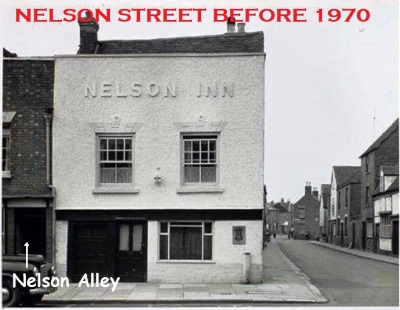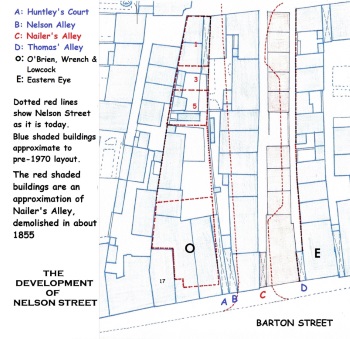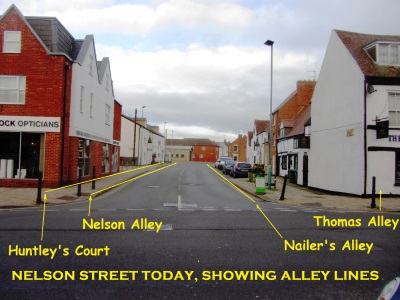Nelson and Nailer Alleys
to Expand
Before the Oldbury Field was developed in the first half of the nineteenth century, there were no roads into the area except Chance Street, which was probably a farm track. The High Street ‘back lane’ was Oldbury Road, and the Barton Street ‘back lane’ was East Street. Neither would have been more than footpaths. With development, from the 1820s, the roads were made and new access roads created. The first were from the High Street; Trinity Street and Sun Street. Nelson Street came a little later, sometime after 1855.
The street was created by demolishing a row of houses between two alleys. Those were Nailer’s Alley and Thomas Alley. The Nailer’s Alley properties were all demolished, but the Thomas Alley cottages now front Nelson Street, on the east side. The ‘front House’, occupied by the Thomas family, is now the Eastern Eye restaurant. The remnants of the alley can be seen as a ‘nib’ protruding into the Nelson Street pavement.
to Expand
The demolished Nailer’s Alley contained five nail shops and three cottages as well as a coal yard behind a ‘front house’ on Barton Street. In 1848, when the freehold of most of this property was auctioned, it was noted that the shops were leased to Thomas Weyman for ten years at £12 per annum.
Thomas Weyman was a partner in Bryges and Weyman, ironmongers, whose business was conducted from 3 & 4 High Street. They specialised in agricultural ironmongery (nails for horse shoes were profitable). It is likely that the nail makers rented their shops off Weyman and worked on piece-work, buying their iron bar from him and being paid for the nails at the end of the week. It is said that they could make nails at a rate of 250 an hour.
Nail making was once a substantial industry in Tewkesbury, but like much else, was based in houses and workshops rather than factories. The principal areas seems to be Tolsey Lane and Barton Street. In 1895, the “Register”, recording the death at 95 of James Hill, supposedly the very last nail maker, recalled that:
to Expand
“In certain departments of the work women were employed, and many of Tewkesbury's elders will still be able to recall the interest with which they stood at the open doors of the little smithies in Prior's-alley or Nailers'-alley and watched the amazing rapidity with which men and women alike converted the lank iron bar into perfect nails of all sorts and sizes.”
The Midland Mining Commission painted a much less nostalgic picture in their report of 1843 after disturbances in the main nail-making areas of Bromsgrove and Dudley: ‘The best forges are little brick shops of about 15 feet by 12 feet in which seven or eight individuals constantly work together with no ventilation except the door and two slits, a loop-hole in the wall. The majority of these workplaces are very much smaller and filthy dirty and on looking in upon one of them when the fire is not lighted presents the appearance of a dilapidated coal-hole. In the dirty den there are commonly at work, a man and his wife and daughter, with a boy or girl hired by the year. Sometimes the wife carries on the forge with the aid of the children. The filthiness of the ground, the half-ragged, half-naked, unwashed persons at work, and the hot smoke, ashes, water and clouds of dust are really dreadful’.
Nailers were among the poorest and most exploited of workers. The Rev. Edmund Butcher passed through Tewkesbury in 1805, on a journey to Chester, and remarked on the nail-making. He said that the persons employed were, in general, so rude and savage that it was scarcely deemed safe for the other inhabitants to go into their quarter, especially if any umbrage has been taken against them by any of the nailers. This seems unusually harsh. There is no other evidence, from the Borough Courts, for instance, to suggest that nailers were more lawless than other residents. Maybe it was a reaction to seeing them at work at their forges.
For many years, the line of Nailer’s Alley was the west pavement of Nelson Street. The street was widened in the 1980s, though, and the old Nelson Inn, plus the cottages behind it which formed Nelson Alley were also demolished. Nelson Alley has completely disappeared, and the new building line follows what would have been Huntley’s Court. The only trace of the original buildings, though, is 1, Nelson Street. This has been partially rebuilt, but was once at the top of Huntley’s Court. Look carefully at the gable, and the infill to the alley can be seen in the brickwork.Like so many cottage industries, nail making was ended by the industrial revolution. Automation led to factories, and these were established close to the raw materials in South Wales, the Midlands and the North. Avoncroft Museum at Bromsgrove has preserved buildings from the last days of hand nail-making. It takes a lot of imagination to hear the distant clang of hammers on anvils when walking down Nelson Street, but the nails made there are probably still holding pieces of Tewkesbury together.





Comments